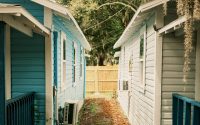Inside a Mexican Billionaire’s Hideaways Turned Hotels
About 10 years ago, when I was living in Mexico, I went to a party at a beach house that belonged to a friend. It was an overcast afternoon on the Pacific Coast, but there’s a certain moment at the end of the day when the sun dips under the clouds and floods everything in light. It was then that we all saw what wasn’t visible before: a mansion, in the distance across the bay, sitting alone on its own beach, with a blue dome and fiery orange walls suddenly glowing in the dark forest that surrounded it. Someone said it had been built by the billionaire corporate raider Sir James Goldsmith in 1989. There were zebras and African antelope on the grounds; Ronald Reagan and Henry Kissinger had both been guests.
“Who’s there now?” I asked.
“It’s a hotel,” someone else said, adding I could stay there too if I wanted.
That kind of ostentatious luxury felt a little too much like Pablo Escobar, the Colombian drug kingpin, for me at the time. But I am also a curious person, who in the last decade has watched the rise of a billionaire class that vanishes into retreats just like that one. I’ll even admit to fantasizing about what it would be like to step into that “Great Gatsby” universe that exists parallel to our own, sometimes so close that it can be seen across the bay — a blue dome illuminated like a light blinking in the distance. Would it be what I imagined? After pondering it for years, last spring I made reservations to see how the billionaire once lived and learn a little bit about him.
Goldsmith’s 1997 obituary in The New York Times describes him as “a flamboyant British-French financier who maintained three families, homes in four countries and used his billions to fight the European Union.” He died at age 64 in Spain of a heart attack. It was a sudden end to a contentious life, which he first dedicated to corporate raiding against companies like Goodyear, then to politics, when — presaging Brexit by about two decades — he formed his own political party whose sole objective was a referendum on Britain’s future in the European Union. Along the way, he bought two properties in Mexico: Cuixmala, the mansion I saw on the coast in the state of Jalisco, and Hacienda de San Antonio, a former coffee plantation from the 19th century in the nearby state of Colima.
“He was one of a kind,” said Alix Marcaccini, Goldsmith’s daughter with his second wife, Ginette Lery, who runs both estates these days and whose memories of her father are less about his politics than his obsession with details, like tracing mock-ups of the pools on the ground with chalk. “My father had this childlike quality; he was constantly amazed by the simple beauty of things. He always said, ‘If you have built something that’s not nice, don’t keep it, as your eye will get used to it.’”
In the lair of the ‘Tin King’
My journey into Goldsmith’s aesthetic world began at Hacienda de San Antonio. Mexico’s landscape has no shortage of plantations from bygone eras that now sit in ruins like something out of an Edgar Allan Poe story. But not this one: The drive to the hacienda, at the end of a manicured road on the property, ends at the main house, which rises up in pink and black, looking as if it had been built yesterday.
Tropical birds were singing in the midafternoon sun as I walked around to see the place. There was a winding garden with fountains and geometric hedges meant to evoke the Alhambra in Spain. A pool with a checkerboard bottom recalled the one at Hearst Castle in California. But the looming volcano in the background made it clear that I was in neither of those other Xanadus: The Volcán de Colima, one of the most active in Mexico, sits just eight miles away and can often be seen puffing whiffs of smoke.
My room was a large chamber with ceilings that rose up a dozen feet, hardwood beams above and a fireplace beckoning a few paces from the bed. I opened the armoire expecting a closet, but found a minibar inside, stocked with shakers, wine glasses and a kind of grappa made on-site using mango — mangrappa, they called it. I popped open the bottle, stretched out in the chaise longue and cracked open a book. It couldn’t have been more cozy.
After dinner and a quiet night, I set out the next day with Eliceo Ramírez Castellanos, a guide on the property who goes by the nickname Chito, to Rancho Jabalí, the 5,000-acre working ranch that adjoins the plantation house. Mr. Ramírez began the ranch’s story with his own. His family, he said, had tended the ranch even before Goldsmith bought it, having settled in a village of several hundred people that was founded to run the sprawling hacienda. The first owner had been a German coffee magnate named Arnoldo Vogel, who came to plant Arabica bushes in the 1870s. The plantation’s coffee was served, legend has it, to the German imperial family.
Mr. Ramírez parked the car and went into the stables, returning with a pair of horses that we mounted and started riding into the forest. It was the dry season in Mexico and the forest was parched; the leaves crackled under the horses’ hooves. Mr. Ramírez continued the story of the hacienda: Vogel died in the 1920s, he said, and after some decades of disrepair the plantation was snapped up by a Bolivian mining tycoon, Antenor Patiño, known in the press by his nickname, the Tin King. Goldsmith, Mr. Ramírez said, had married a daughter of Patiño’s and later bought the hacienda after acquiring the land to build Cuixmala, his other Mexican estate.
Coffee, mining, Wall Street finance — the staples of this plantation varied with the times, I told Mr. Ramírez. We had gotten off the horses and were looking at the landscape around us: a waterfall, a lake and towering trees. Mr. Ramírez made a gesture. “This part doesn’t change with the owners,” he said.
The night felt chilly, which never ceases to surprise me in the tropics. “It’s the altitude,” said the woman who came to light the fireplace in my room — we were, after all, where coffee used to be grown, at nearly 4,000 feet above sea level. I still couldn’t resist the temptation to have a look at the stars, so I put on a sweater. You could see Sagittarius, teapot-shaped, and the Milky Way pouring out of its spout. I wandered to the tiny chapel dedicated to St. Anthony, for whom the hacienda was named, where a couple of candles were burning. I’d been told earlier it was built when an eruption spared the plantation after Vogel’s wife had prayed to the saint. In the distance, the volcano sat quietly in the moonlight.
Under the dome
The next day, I was on my way to Cuixmala. The journey is all downhill, first through the state capital of Colima and then along a fast highway until you reach the ocean, where the air is suddenly humid and coconut plantations stretch out for miles. Two hours after leaving San Antonio, I made a left turn at a nondescript sign. A man with a clipboard lifted a barrier and told me to follow his colleague, who was waiting for me on a motorcycle.
Five minutes down the dusty road, the man on the motorbike stopped and pointed to the lagoon we were passing. A crocodile slithered into the water, then a second one. There was something else moving in the distance, so I squinted. It was a herd of zebras grazing in a field beyond the water. Cuixmala, it turned out, dwarfed the hacienda in size — some 36,000 acres in all, most of which serves as a nature reserve for a menagerie of African animals, along with countless native species like jaguar and ocelot, and is tended by a staff of around 400.
I’d seen Goldsmith’s mansion at that party years before, but that fleeting sight hardly prepared me for what it would be like to see the place when it filled my field of vision. The dome, which had been only a tiny dot from far away, now was a massive tiled rotunda with blue and yellow chevrons sitting atop the roof. Two bronze statues — a rhinoceros and a gorilla — guarded the entrance, playfully.
I walked up the grand steps, feeling a bit like a prince, passing fountains and more sculptures. It was the golden hour, and the wind was blowing in through a curtain in the window. I looked out: About a hundred feet below, a secluded, mile-long beach stretched out, the waves crashing in from the Pacific.
Goldsmith’s architect, the Frenchman Robert Couturier, had opted for an almost imaginary blend of Mexico and Morocco. There was Moorish-style latticework on the doors, and halls filled with handicraft ceramics from Michoacán. The scale was enormous. I passed a whitewashed library filled with books and red divans to read them on. I passed a 10-sided courtyard with a fountain and entered my room — one of just four in the mansion — where I was greeted by a dragon alebrije, a colorful Mexican statuette that tourists often take home in their suitcases. This one stood on its hind legs and was as tall as me.
Cuixmala has two private beaches, and the next morning I headed to the second one. The property’s boat captain was waiting to take me out to see what lay north along the coast. No zebras and eland, it seemed — the Goldsmith reserve quickly gives way to a series of other luxury mansions, each with its own pier. (Ms. Marcaccini spent years battling her neighbors, including the Mexican billionaire Roberto Hernández, to block development.) We passed an abandoned fishing village on an island; encouraged, we threw out a fishing line, but the fish weren’t biting that day.
On my last night in Cuixmala, Efraín Saucedo, the house manager, revealed a surprise: “All the other guests checked out today, so the house is yours tonight.”
Such a chance, I knew, wasn’t likely to come again, not even if I came back. Where would I start? First, I asked for a margarita and headed out to watch the sunset over the ocean. The drink was strong; the reds and purples in the sky were swirling like Diego Rivera’s “Evening Twilight at Acapulco.” Then I headed into the reading room, pulled out a copy of the first book I found (a thick tome with pictures of ancient Mesoamerican pottery), and pretended as if the whole library belonged to me.
What was it like to feel like a billionaire for a night? I’ll say it was a little bit lonely. The world’s most beautiful places should never be the domain of just one person — they’re meant to be shared.
As I fell asleep I thought I could hear a party from another beach house in the distance. And I imagined someone looking at the mansion, as I once did, wondering who was there.
If You Go
Both the Mexican states of Jalisco and Colima currently have State Department advisories against travel because of crime and kidnapping, something to strongly consider before making the trip yourself.
Getting there: The main airport serving both hotels is Playa de Oro International Airport in Manzanillo, 90 minutes from Cuixmala and two hours from Hacienda San Antonio. The hotels also arranges private charters from various points in Mexico.
Cuixmala: Suites in the main house range from $880 to $2,200 per night during summer and early fall; from $1,100 to $2,750 during winter and spring. The property also has private villas that go for as much as $7,700 per night, and smaller casitas for around $600 per night.
Hacienda San Antonio: Rooms range from $760 to $1,300 per night during summer; from $980 to $1,900 during winter.
Follow New York Times Travel on Instagram and sign up for our weekly Travel Dispatch newsletter to get expert tips on traveling smarter and inspiration for your next vacation. Dreaming up a future getaway or just armchair traveling? Check out our 52 Places to Go in 2023.


